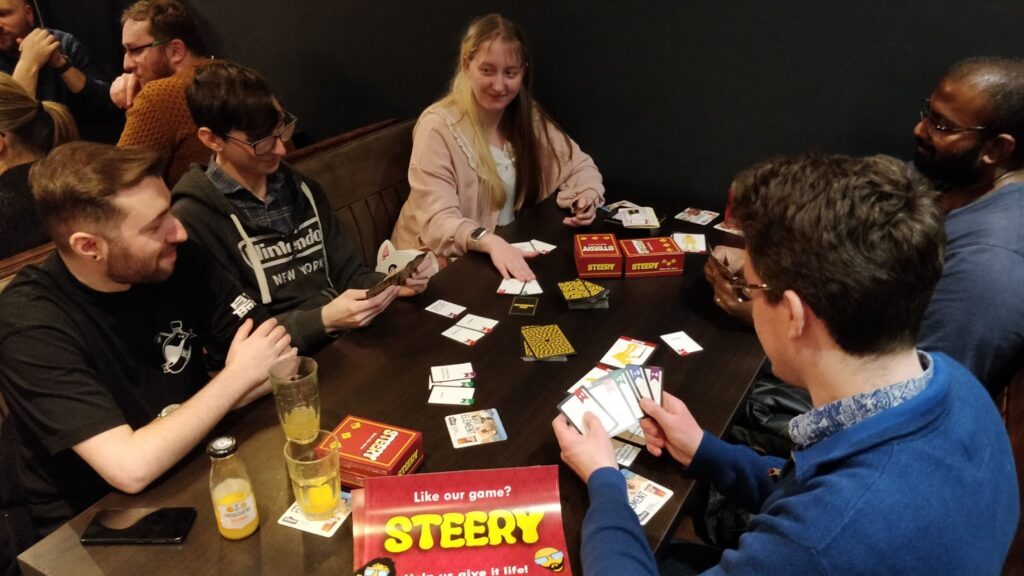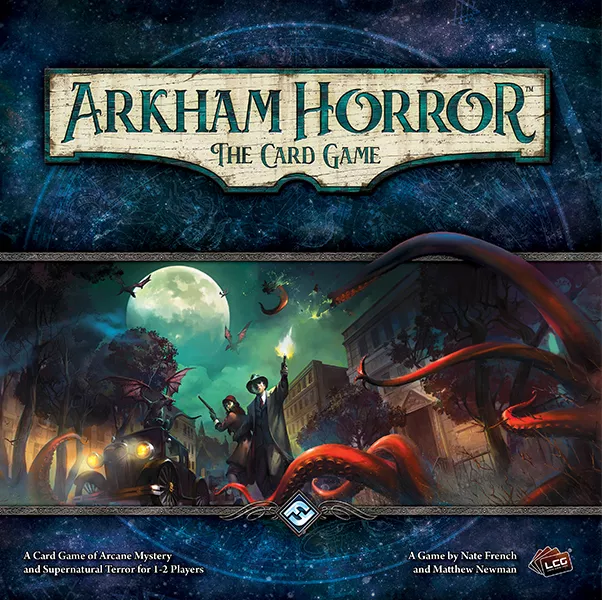
Joe: Thanks for agreeing to this conversation. We’re going to be talking about ‘storytelling’ and I’m guessing with your game STEERY, there’ll be lots to say.
First, can you tell me a little bit about you and how your game STEERY came to be?
Atomic Blips: Irina here, thank you so much for the invitation! STEERY’s origin story is quite a funny one, actually. One evening, while wrapping up a really fun game night with some friends and putting all of our party games away, my husband Sam said to me: “It would be so cool if we made our own party game, one where you tell stories with the other players”. To which I responded sarcastically “Pffft, yeah, sure, we’ll make a party game alright.” Two and a half years later here we are, with two printed iterations of Steery, a third one in the works, and a Kickstarter pre-launch page!
While we’re at origin stories, can you tell us how your blog came to be?
Joe: I’ve never blogged before, in fact I’m usually quite reticent of making any kind of comments on the internet. But after exploring Instagram for a few months I decided I might have something interesting to say about games design. Turns out it was more other people’s stories that I’m keen to tell, they’re far more interesting as I don’t already know them!
What do you think it is about stories and games with stories that makes them so popular?
Irina: Well, I think most of us wake up in the morning, do our freshen up routine, possibly commute to work/school and back, do a chore, cook a meal, before we go to sleep to start all over again the next day. If we’re lucky enough, we may have one hour or so left to invest in one of our hobbies. This is quite a common lifestyle in today’s society, but pretty quickly it can become monotonous, predictable. I believe it is in our nature to seek new and exciting things, to want to discover different experiences, and good storytelling opens a little window for us to peep through into a world where everything is possible, and nothing is ever the same.
storytelling opens a little window for us to peep through into a world where everything is possible
Whether it’s a movie, a game, a book, or an interview about someone’s journey in board game design, we are being immersed in a completely different universe and we can participate in adventures that could never compare to our day to day life. When you view storytelling under this light, it is very tempting to dedicate to it the little spare time you have left out of your busy day.
Do you experience monotony in your day to day life? What do you do to escape it?
Joe: Fantastic answer and a great question. I’m really lucky, throughout my work I’ve always had the opportunity to create. In my day job, that’s creating education experiences that support young people to study STEM subjects. Then my evenings are filled with as much creativity as I can pack in: usually games design, sometimes art or graphic design, depending on how the mood takes me. You’ve got to put time aside for that creative side, because if you don’t. That time does disappear.
Steery is all about storytelling – but that’s something that can be quite daunting for people – how have you thought about that as you’ve been developing the game?
Irina: Storytelling indeed requires a lot of inspiration and creativity; a good story is well structured but also innovative enough to keep the audience engaged. It’s not an easy skill to practise, and I can see why STEERY’s theme may intimidate some people. We’ve had a few people tell us before that our game requires way more imagination than they can deliver. But we’ve also had playtesters who gave STEERY a try even though at first it didn’t seem like their cup of tea, and in the end they had a blast playing it.

One reason why we decided to make STEERY a party game (as opposed to a different type of game) was because we wanted to remove some of the performance anxiety that comes with storytelling, and create a much more casual, relaxed and fun context for you to express yourself and be creative. STEERY being semi-cooperative also helps, because you don’t have the burden of telling an entire story yourself, but you build it card by card together with your group, and you get rewarded with points for each contribution to the story.
Storytelling is a topic very dear to Sam, but I would have never got into it if it wasn’t for STEERY, precisely because it felt daunting to me. I still feel a bit of an imposter sometimes when I play STEERY with a brilliant and extroverted group. But our game eased me into this world, and it helped me grow so much, and have more faith in my creative self.
Have you ever played a tabletop game that took you out of our comfort zone before?
Joe: Some of the large player count, social deduction games take me well out of my comfort zone. Blood on the Clocktower is a good example, it has solid story vibes too, but if I’m honest it’s a bit much, and I need a lie down after playing! I may not enjoy it, but I can see such clever beauty in that game! I like smaller games like Werewolves, and The Resistance though, they give me the same vibes, but somehow without the nerves I get from Clocktower.
I’m really interested in the fact that games can be stories, even when they are not about telling stories. And that games feel like such a safe space for stories to come alive. I think this might be something to do with a shared set of rules.
Irina: Yes exactly, a safe space where you can express yourself and have fun in the process. The beauty of it is that the process gives birth to unique stories every time, whether the game itself is the story or whether the game is a storytelling framework. That’s because it’s the people that breathe life into the games they play and the stories that come with them. And it’s not just about the stories within the game, but also within the player, their life experiences, their sense of humour, their personality. These are the things that turn ink printed on paper into extraordinary universes.
the process gives birth to unique stories every time
This is another thing we tried to achieve in STEERY. Give the players enough content on the cards to steer them in a particular direction, but allow enough ambiguity and wiggle room for the players to really make that story theirs. And the response has been overwhelmingly positive.
Is there a story from the boardgames world that you can call your favourite? Which one and why?
Joe: Excellent question! I played Arkham Horror for the first time a few months ago and absolutely loved the narrative. It’s such a clever game that allows you to play within a story, but to explore around what is possible in that space. It’s also collaborative, which I really enjoy. I also enjoyed Lost Ruins of Arnak, the narrative there is solo, but you can feel real progression through the story laid out by the game.

Here’s a final question for you: what advice would you give to games designers to help them develop how they are using storytelling and stories in their games?
Irina: We would say that the build up in storytelling is extremely important. Apart from your characters, theme, conflicts, and plot developments, you really need your game to build the story up in a way that ties all those elements together well, and keeps your players engaged and immersed. It’s the build up that makes the cliffhangers and plot twists more emotionally impactful, and it’s the build up that makes the players feel like they really went on a ride! Have a think about that when designing your game!
One moment, don’t stop reading…
Joe here, two asks of you today:
- number one, go find and follow Atomic Blips, the folks behind STEERY over on Instagram and follow their kickstarter prelaunch!
- number two I need your support. If you’ve enjoy what you read and want more, I can’t rely on the Instagram algorithm to make sure that you know when the next post will land. So please drop your email into the box below if you want to make sure you get the next post straight to your inbox.


